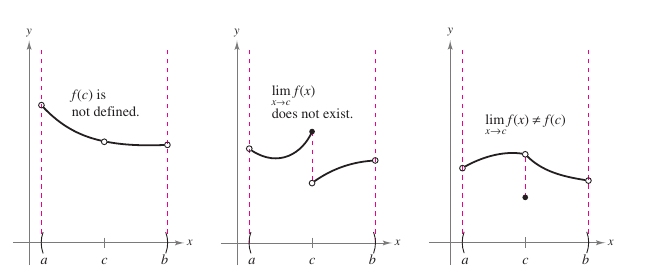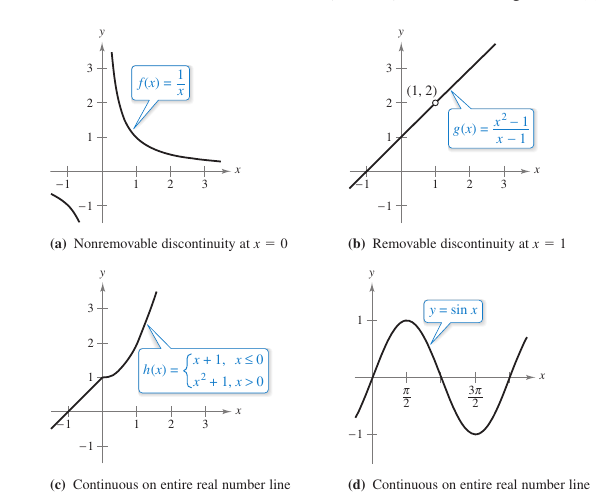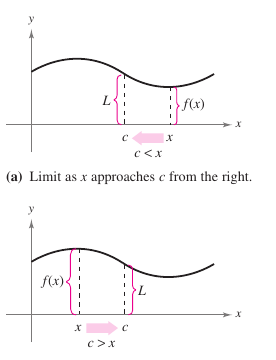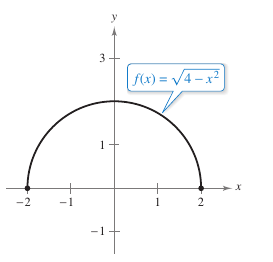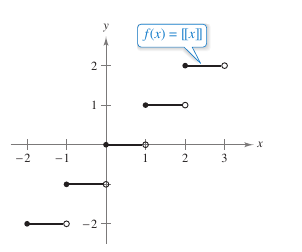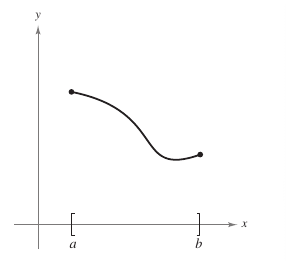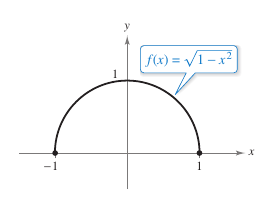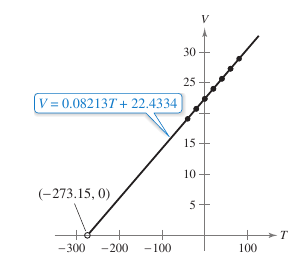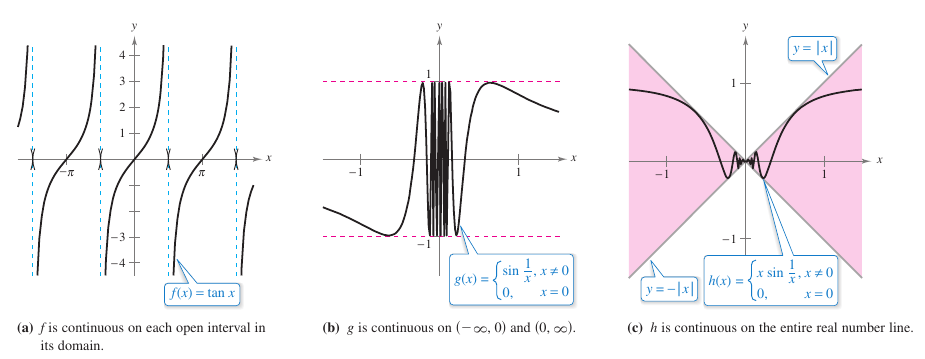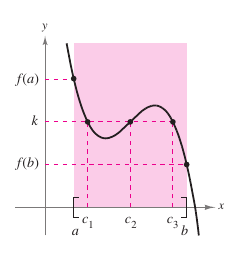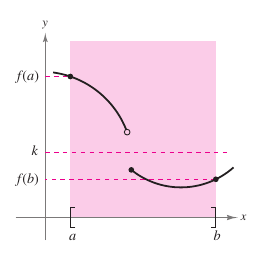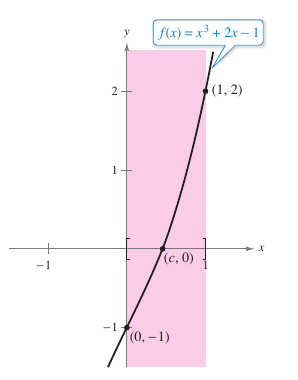Calculus I 01.04 Continuity and One-Sided Limits
| Previous | Calculus I 01.03 Evaluating Limits Analytically |
| Next | Calculus I 01.05 Infinite Limits |
Contents
- 1 Continuity at a Point and on an Open Interval
- 1.1 Definition 1.4.1 Continuity Definition
- 1.2 Example 1.4.1 Function Continuity
- 1.3 One-Sided Limits and Continuity on a Closed Interval
- 1.3.1 Example 1.4.2 A One-Sided Limit from the Right
- 1.3.2 Example 1.4.3 The Greater Integer Function
- 1.3.3 Theorem 1.4.1 Evidence a Limit Exists
- 1.3.4 Definition 1.4.2 Continuity on a Closed Interval
- 1.3.5 Example 1.4.4 Continuity on a Closed Interval
- 1.3.6 Example 1.4.5 Charles's Law and Absolute Zero
- 1.4 Continuity Properties
- 1.5 The Intermediate Value Theorem
- 2 Internal Links
Continuity at a Point and on an Open Interval
- Determine continuity at a point and continuity on an open interval.
- Determine one-sided limits and continuity on a closed interval.
- Use continuity properties.
- Describe the Intermediate Value Theorem.
A function \(f\) is mathematically continuous at \(x=c\) if the graph for \(f\) has no interruption, holes, jumps, or gaps at \(f(c)\). Figure 1.4.1 describes three values for \(x\) at which the graph for \(f\) is not continuous. At all other points on the interval \((a,b)\), the graph is uninterrupted and continuous.
Figure 1.4.1 shows that continuity at \(x=c\) can be destroyed by three conditions.
- The function is not defined at \(x=c\).
- The limit for \(f(x)\) does not exist at \(x=c\).
- The limit for \(f(x)\) exists at \(x=c\), but is not equal to \(f(c)\).
If none of the three conditions is true, then the function \(f\) is called continuous at \(\mathbf{c}\), as described in the definition below.
Definition 1.4.1 Continuity Definition
| A function \(f\) is continuous at \(\mathbf{c}\) when three conditions are met. |
| 1. \(f(c)\) is defined. |
| 2. \(\lim_{x \to c} f(x)\) exists. |
| 3. \(\lim_{x \to c} f(x)=f(c)\) |
| Continuity on an Open Interval |
| A function is continuous on an open interval \(\mathbf{(a,b)}\) when the function continuous at each point on the interval. A function that is continuous |
|
|
Consider an open interval \(I\) that contains a real number \(c\). If a function \(f\) is defined on \(I\) (except possibly at \(c\)), and \(f\) is not continuous at \(c\), then \(f\) is said to have a discontinuity at \(c\). Discontinuities fall into two categories: removable and non removable. A discontinuity at \(c\) is called removable when \(f\) can be made continuous by appropriately defining (or redefining) \(f(c)\). For instance, the functions shown in Figures 1.4.2(a) and (c) have removable discontinuities at \(c\) and the function shown in Figure 1.4.2(b) has a non removable discontinuity at \(c\). Example 1.4.1 Function ContinuityDefine the continuity for each function.
|
One-Sided Limits and Continuity on a Closed Interval
|
|
To understand continuity on a closed interval first look at a new limit called one-sided limit. For example, the limit from the right (or right-hand limit) means that as \(x\) approaches \(c\) from values greater than \(c\) [see Figure 1.4.4(a)]. This limit is denoted as
Similarly, the limit from the left (or left-hand limit) means that \(x\) approaches \(c\) from values less than \(c\) [see Figure 1.4.4(b)]. This limit is denoted as
One-sided limits are useful in taking limits for functions involving radicals. For example, if \(n\) is an even integer, then
|
Example 1.4.2 A One-Sided Limit from the Right
|
|
Find the limit for \(f(x)=\sqrt{4-x^2}\) as \(x\) approaches -2 from the right.
One-sided limits can be used to investigate behavior in step functions. One common step function is the greatest integer function [\![x]\!], defined as
For example, \([\![2.5]\!]=2\) and \([\![-2.5]\!]=-3\). |
Example 1.4.3 The Greater Integer Function
|
|
Find the limit for the greatest integer function \(f(x)=[\![x]\!]\) as \(x\) approaches 0 from the left and from the right.
and the limit as \(x\) approaches 0 from the right is
The greatest integer function has a discontinuity at zero because the left- and right-handed limits at zero are different. By similar reasoning, the greater integer function has a discontinuity at any integer \(n\). |
|
|
Theorem 1.4.1 Evidence a Limit Exists
The one-sided limit concept extends the continuity definition to closed intervals. Basically, a function is continuous on a closed interval when it is continuous on the interval's interior and exhibits one-sided continuity at the endpoints. This is stated formally in the next definition. Definition 1.4.2 Continuity on a Closed Interval
Similar definitions can be written to cover continuity on intervals with the form \((a,b]\) and \([a,b)\) that are neither open nor closed, or on infinite intervals. For example,
is continuous on the infinite interval \([0,\infty)\), and the function
is continuous on the infinite interval \((-\infty,2]\). |
Example 1.4.4 Continuity on a Closed Interval
|
|
Describe the continuity for
Solution The domain for \(f\) is the closed interval \([-1,1]\). At all points in the open interval \((-1,1)\), the continuity for \(f\) follows from Theorems 1.3.4 and 1.3.5. Moreover, because
conclude that \(f\) is continuous on the closed interval \([-1,1]\), as shown in Figure 1.4.8. |
Example 1.4.5 Charles's Law and Absolute Zero
Continuity Properties
Section 1.3 described limits and their properties. Each property yields a corresponding property pertaining to a function's continuity. For instance, Theorem 1.4.2 follows directly from Theorem 1.3.2.
Theorem 1.4.2 Continuity Properties
| If \(b\) is a real number and \(f\) and \(g\) are continuous functions at \(x=c\), then the functions listed below are also continuous at \(c\).
|
It is important to recognize functions that are continuous at every point in their domains. The list below summarizes the functions covered in this discussion that are continuous at every point in their domains.
| 1. Polynomial: | \(p(x)=a_{n} x^n+a_{n-1} x^{n-1}+...+a_{1}x+a_{0}\) |
| 2. Relational: | \(r(x)= \frac{p(x)}{q(x)}, \:\:\:\: q(x) \neq 0\) |
| 3. Radical: | \(f(x)=\sqrt[n]{x}\) |
| 4. Trigonometric: | \(\sin x, \cos x, \tan x, \cot x, \sec x, \csc x\) |
Applying Theorem 1.4.2 with this list reveals many elementary functions are continuous at every point in their domains.
Example 1.4.6 Applying Continuity Properties
By Theorem 1.4.2, it follows that each function below is continuous at every point in its domain.
- $$f(x)=x + \sin x,\:\:\:\:f(x)=3 \tan x,\:\:\:\:f(x)=\frac{x^2+1}{\cos x}$$
Theorem 1.4.3, which follows from Theorem 1.3.5, determines the continuity for composite functions such as
- $$f(x)=\sin 3x,\:\:\:\:f(x)=\sqrt{x^2+1},\:\:\:\text{and}\:\:\:f(x)=\tan \frac{1}{x}.$$
Theorem 1.4.3 Continuity for a Composite Function
| If \(g\) is continuous at \(c\) and \(f\) is continuous at \(g(c)\), then the composite function given by \((f \circ g)(x)=f(g(x))\) is continuous at \(c\). One consequence is the limit for \(f(g(x))\) as \(x\) approaches \(c\) is
|
Proof By the definition for continuity, \(\lim_{x \to c}g(x)=g(c)\) and \(\lim_{x \to g(c)}f(x)=f(g(c))\). Apply Theorem 1.3.5 with \(L=g(c)\) to obtain
- $$\lim_{x \to c} f(g(x))=f \left ( \lim_{x \to c} g(x) \right)=f(g(c)).$$
Therefore, \((f \circ g)(x)=f(g(x))\) is continuous at \(c\).
Example 1.4.7 Testing for Continuity
Describe the intervals(s) on which each function is continuous.
- $$\mathbf{\text{a.}}\:f(x)=\tan x\:\:\:\: \mathbf{\text{b.}} \: g(x)=\left\{\begin{matrix} \sin \frac{1}{x}, & x \neq 0\\ 0,& x=0 \end{matrix}\right. \:\:\:\: \mathbf{\text{c.}}\:h(x)=\left\{\begin{matrix} x \sin \frac{1}{x}, & x \neq 0 \\ 0, & x=0 \end{matrix}\right.$$
Solution
| a. | The tangent \(f(x)= \tan x\) is undefined at
At all other points, \(f\) is continuous. So, \(f(x) = \tan x\) is continuous on the open intervals
As shown in Figure 1.4.10(a) |
| b. | Because \(y=1/x\) is continuous except at \(x=0\) and the sine function is continuous for all real values for \(x\), if follows from Theorem 1.4.3 that
is continuous at all real values except \(x=0\). At \(x=0\), the limit for \(g(x)\) does not exist (see Section 1.2 Example 1.2.5). Thus, \(g\) is continuous on the intervals \((-\infty,0)\) and \((0,\infty)\), as shown in Figure 1.4.10(b). |
| c. | This function is similar to the function in part (b) except that the oscillations are
damped by the factor \(x\). Using the Squeeze Theorem obtains
and conclude that
Therefore \(h\) is continuous on the entire real number line, as shown in Figure 1.4.10(c) |
The Intermediate Value Theorem
|
|
Theorem 1.4.4 The Intermediate Value Theorem
The Intermediate Value Theorem states that at least one number \(c\) exists, but it does not provide a method for finding \(c\). Such theorems are called existence theorems. The proof for this theorem is based on a property for real numbers called completeness. The Intermediate Value Theorem states that for a continuous function \(f\), if \(x\) takes on all values between \(a\) and \(b\), then \(f(x)\) must take on all values between \(f(a)\) and \(f(b)\). For an example, consider a person’s height. A girl is 5 feet tall on her thirteenth birthday and 5 feet 7 inches tall on her fourteenth birthday. Then, for any height \(h\) between 5 feet and 5 feet 7 inches, there must have been a time \(t\) when her height was exactly \(h\). This seems reasonable because human growth is continuous and a person’s height does not abruptly change from one value to another. The Intermediate Value Theorem guarantees that at least one number c exists in the closed interval \([a,b]\). There may be more than one number \(c\) such that
as shown in Figure 1.4.11. A function that is not continuous does not necessarily exhibit the intermediate value property. For example, the graph for the function shown in Figure 1.4.12 jumps over the horizontal line
and for this function there is no value for \(c\) in \([a,b]\) such that \(f(c)=k\). The Intermediate Value Theorem often can be used to locate a function's zeros as long as it is continuous on a closed interval. Specifically, if \(f\) is continuous on \([a,b]\) and \(f(a)\) and \(f(b)\) differ in sign, then the Intermediate Value Theorem guarantees the existence of at least one zero of f in the closed interval \([a,b]\). |
Example 1.4.8 Applying the Intermediate Value Theorem
|
|
Use the Intermediate Value Theorem to show that the polynomial function
has a zero in the interval \([0,1]\).
it follows that \(f(0)<0\) and \(f(1)>0\). Therefore the Intermediate Value Theorem can be applied to conclude that there must be some \(c\) in \([0,1]\) such that
as shown in Figure 1.4.13. The bisection method for approximating the real zeros for a continuous function is similar to the method used in Example 1.4.8. If zero is known in the closed interval \([a,b]\), then the zero must lie in the interval \([a,(a+b)/2]\) or \([(a+b)/2,b]\). From the sign for \(f(a+b)/2)\), the interval containing the zero can be determined. Repeatedly bisect the interval until the zero is revealed. |
Internal Links
Parent Article: Calculus I 01 Limits and Their Properties
